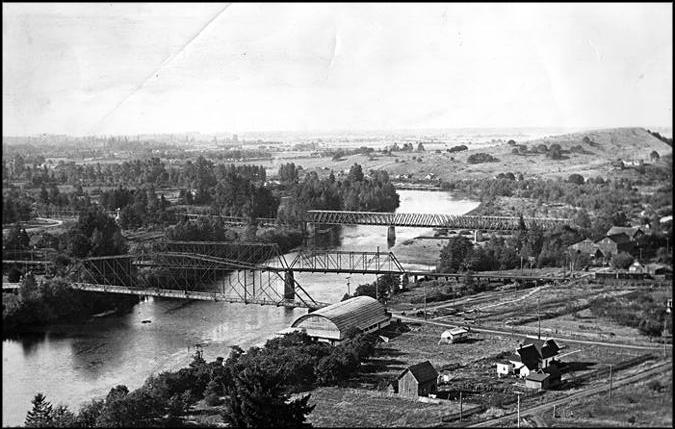Springfield Main Street Bridge
From Lane Co Oregon
(→1870s) |
(→1880s) |
||
| Line 6: | Line 6: | ||
The bridge was flooded out and replaced in [[1881]]. The new structure featured a Smith truss bracing system and 220-foot span (Special Collections n.d.: Box 66-20, Folder 7A/B). | The bridge was flooded out and replaced in [[1881]]. The new structure featured a Smith truss bracing system and 220-foot span (Special Collections n.d.: Box 66-20, Folder 7A/B). | ||
| + | |||
| + | Like the Titanic, the 1881 Springfield bridge over the Willamette River was expected to last forever. In the words of a local newspaper at the time, “When a flood comes high enough to take that bridge away, it will be either a second deluge or the end of the world.” | ||
| + | |||
| + | Nine years later the bridge was gone, destroyed by a flood that put downtown Springfield under four feet of water. | ||
=1890s= | =1890s= | ||
Revision as of 18:15, 1 February 2008
1870s
- The Briggs Ferry continued operation until 1875, at which time a covered bridge was constructed across the Willamette River. The wooden span was 368 feet long and was built by public conscription and county funds (Walling 1884:453).
1880s
The bridge was flooded out and replaced in 1881. The new structure featured a Smith truss bracing system and 220-foot span (Special Collections n.d.: Box 66-20, Folder 7A/B).
Like the Titanic, the 1881 Springfield bridge over the Willamette River was expected to last forever. In the words of a local newspaper at the time, “When a flood comes high enough to take that bridge away, it will be either a second deluge or the end of the world.”
Nine years later the bridge was gone, destroyed by a flood that put downtown Springfield under four feet of water.
1890s
During the summer of 1890 Wm. H. Dall collected at several of these Miocene localities, and by the assistance of Prof. Condon has been able to note a wider distribution of the Eocene than has heretofore been recognized in this State.
Miocene rocks are well exposed at Smith's quarry, 1 mile east of Eugene City, and at Springfield bridge, 2 miles farther east. At the former locality the rocks consist of grayish hard sandstone weathering to a yellowish color, irregularly bedded above, but massive below, dipping about 6° southeast, with a total exposure of about 37 feet. The fossils—Mytilus, Modiola, Mactra, Solen, Natica, Neverita, Purpura, and Lirofusus—are crowded or crushed together along certain lines or layers, and are usually in form of molds recrystallized into spar. The second locality, or that near Springfield, affords an excellent exposure of nearly a mile in length, extending southward from the abutment of the new bridge. The rocks have an easterly dip of from 5° to 8° and form a total perpendicular exposure of about 160 feet; they are overlain unconformably by 5 or 10 feet of alluvial matter which lies on their eroded edges. In the hilly regions, according to the observations of Prof. Condon, they are capped with basalt.
Harris, Gilbert Dennison and William Healey Dall. Correlation Papers: Neocene. Washington: Government Printing Office, 1892. p. 227.

